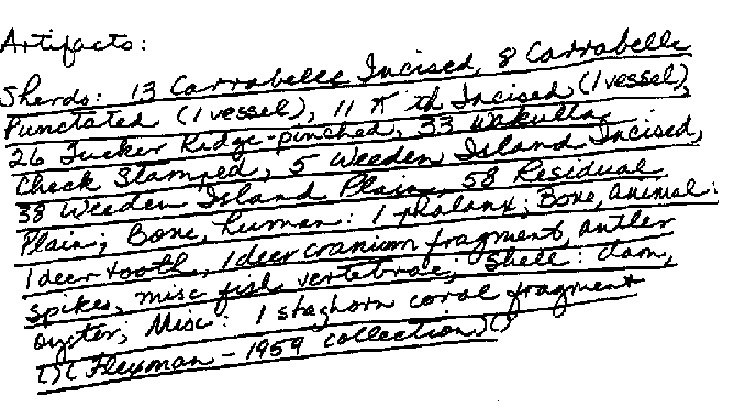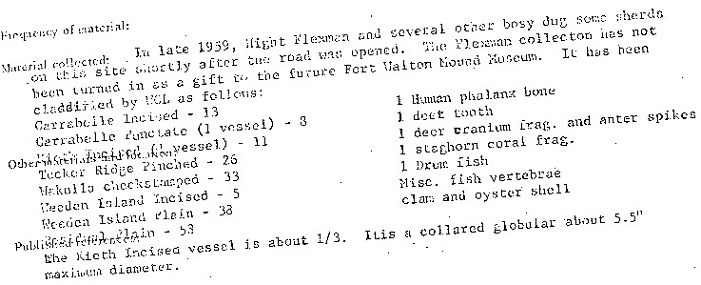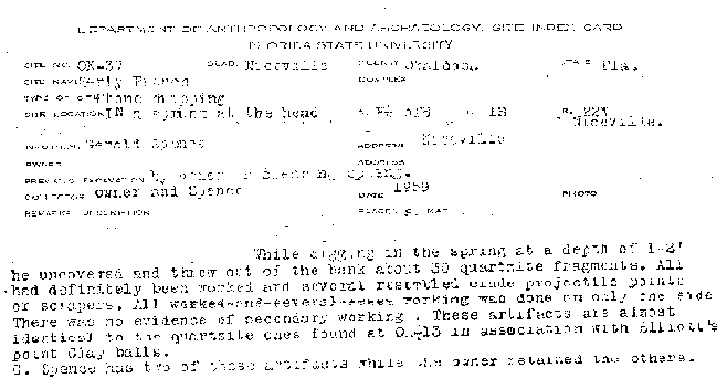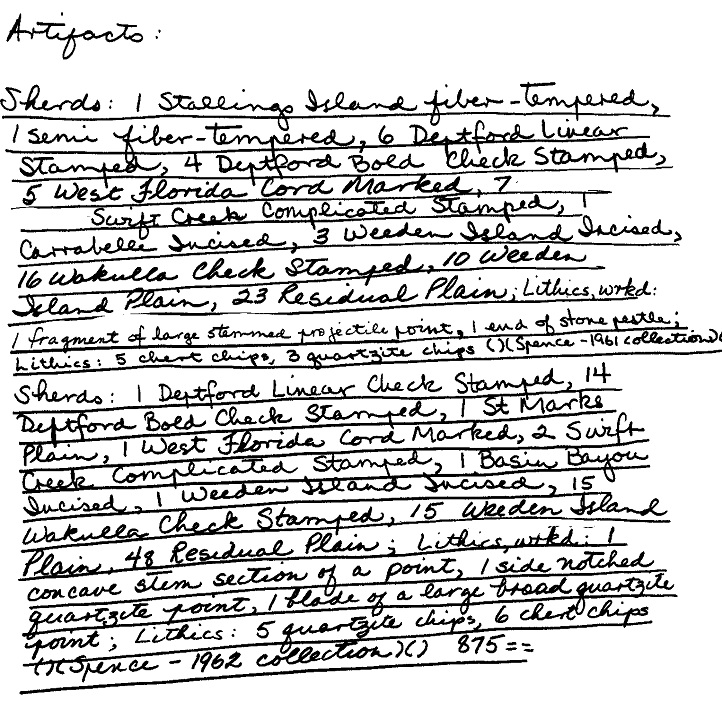Aboriginal Settlements and Artifacts from Niceville
(A section of the NICEVILLE, FLORIDA - Online History Center)
HISTORICAL SOCIETY MUSEUM TO PRESERVE NATIVE AMERICAN HISTORY
Museum Location, Personnel, Publications and Comments:
Location: 115 Westview Ave., Valparaiso, FL 32580 904-678-2615.
Personnel: Mrs. Christian S. LaRoche, Museum Dir. Contact: Christian S. LaRoche, P. O. Box 488, Valparaiso, FL 32580. Founded: 1969; Scope: Local Availability: Open to the public; Admission: Free Visitors: General public, School groups, Ethnic community. Staff: 26 (1 full time, salaried; 25 volunteers); Operating budget: $23,000
Publications: New Growth, quarterly. Collection: Ca. 1,500 books, periodicals, audiovisual materials, artifacts, works of art, and archives (personal papers and correspondence, thesis and dissertations, manuscripts, oral histories). The collection is partially cataloged.
Comments: The mission is to preserve documentary and photographic data and artifacts that illustrate the Native American history and cultural composition of the area. (Source: Guide to information resources in ethnic museum, library, and archival collections in the United States. Authors: Lois Buttlar, Lubomyr Roman Wynar 1996 (Native American Resources p. 247 of 369 pages.)
Former Museum Director Died:
Christian S. LaRoche of Niceville passed away Thursday March 30, 2006 in Pensacola after a sudden fall in her home. (Source: Florida Times Union April 7, 2006)
ABORIGINAL SETTLEMENTS IN THE NICEVILLE AREA
Fort Walton Temple Mound: (Note: This is the most significant aboriginal archaelogical site in the area.)
"Designated a National Historic
Landmark in
1964, Florida's Fort Walton Temple Mound
was once the center of one of the largest and
most advanced civilizations on the Gulf Coast.
Now preserved by the City of Fort Walton
Beach, the mound is 17 feet tall and 223 feet
long across the base. Built 1,000 years ago,
it was the centerpiece of a large group of
smaller mounds located in the heart of what
is now downtown
Fort Walton Beach.
The mound dates from the time of the
Mississippian culture. Due to the size and
significance of the site, archaeologists have
applied the name "Fort Walton" to the phase of the Mississippian culture that
once existed
throughout Northwest Florida.
The Fort Walton site was abandoned by
around 1500 A.D., but scientists remain
uncertain of the exact reason. For unclear
reasons, people of the Mississippian culture
walked away from their massive ceremonial
centers across the South at about that time.
Other mound complexes in Florida, such as
the Lake
Jackson Mounds in Tallahassee,
were similarly abandoned.
It has been speculated that this may have
had something to do with the arrival of
Europeans in North America, but the earliest
Spanish explorers of Florida found the sites
already abandoned.
By the time of the Civil War, the mounds at
Fort Walton Beach had become overgrown
objects of curiosity. Confederate soldiers
established
Camp
Walton at the
base of the
temple mound in 1861 to guard Santa Rosa
Sound and Choctawhatchee Bay. They dug
out a nearby shell mound for use as a
cannon emplacement, exhibiting the relics
and skeletons they found at their camp. The
items were destroyed by fire when Camp
Walton was shelled by Union troops on April
1, 1862." (Source: ExploreSouthernHistory.com - Fort Walton Temple
Mound, Florida)
Mound Near Black Point, Choctawhatchee Bay, Walton County, Florida:
"About one-quarter
mile in a northwesterly direction from Black Point, in scrub, formerly a
cultivated field, on Government property, is a rather symmetrical mound of
circular outline with basal diameter of 83 feet.
The diameter of the
summit plateau is 46 feet. Thorough trenching showed the mound to have been a
place of residence only. Isolated sherds lay here and there in the sand of which
the mound was composed, some of excellent quality, undecorated, with the
check-stamep, with the complicated stamp and with incised decoration."
(Source: The Northwest Florida Expeditions of Clarence Bloomfield
Moore (from 1901 - 1918) pages 80-81)
Mounds Near Rocky Bayou, Choctawhatchee Bay, Walton County, Florida:
"On the west side of
Rocky Bayou, about 1.5 miles up, in scrub, not far from the water's edge, was a
mound, circular in outline, 28 feet across the base and 2 feet 3 inches in
height. A small trench had been dug through the central part.
This mound,
which was demolished by us, was of unstratified sand. Three badly decayed
skulls, each with some fragments of other bones, were met with and a few small
pieces of bone lying alone.
About 8 inches
below the surface, apparently unassociated, was a tobacco pipe of soapstone,
similar to those we found in mounds near the mouth of the St. John's River,
Florida, where the orifice for the stem almost equals in size the bowl of the
pipe. In shape the pipe forms almost a right-angle with one side 4 inches in
length, the other side, 3 inches.
With human
remains, near together, were five small vessels of yellow ware, all perforate as
to the base. Three are undecorated bowls, each of about one-half pint capacity.
Another, semi-globular, 3.6 inches in maximum diameter, has the rim turning
inward to leave an aperture of about 1.7 inches. The height is about 2.4 inches.
The fifth vessel has the form of a gourd. Its length is 4.6 inches; its height,
2.8 inches. The diameter of aperture is 1.4 inches (Fig. 47). The end of the
stem has a small irregular hold which seems to have come through decay.
A graceful
"celt," probably of igneous rock, with well-ground edge and rounded end, 8.5
inches in length, lay near the surface. In various parts of the mound were
several vessels, parts of vessels and sherds, of no particular interest.
About 100 yards east
of the eastern side of the mouth of Rocky Bayou, in a field formerly cultivated
but now overgrown with scrib, is a mound of irr3egular outline, with basal
diameters of 72 feet and 112 feet. The height is 4 feet. Careful trenching gave
every indication that the mound had been dociciliary in character."
(Source: The Northwest Florida Expeditions of Clarence Bloomfield Moore
(from 1901 - 1918) page 81)
Indian Temple Mound Museum:
"Adjacent to the mound is the (Fort Walton) Indian Temple Mound Museum, which preserves more than 6,000 artifacts excavated by archaeologists along Florida's Gulf Coast. Included in the collection are many fine examples of Fort Walton pottery and artwork." (Source: ExploreSouthernHistory.com - Fort Walton Temple Mound, Florida)
ABORIGINAL ARTIFACTS TAKEN FROM TWELVE NICEVILLE ARCHAEOLOGICAL SITES (Source: State of Florida, Department of State, Division of Archives, History and Records Management) (Note: These aboriginal artifacts establish Niceville as a location of prehistoric settlement. These artifacts were not preserved in Niceville and are difficult to locate today. Most probably some artifacts went to the Indian Temple Mound Museum (see above) as the recorder for some sites was W. C. Lazarus who gave the museum as his address.
1. Aboriginal, Pre-Columbian Artifacts from Site OK34 Niceville, Reporter W.C. Lazarus and Gerald Spence (1951):


2. Aboriginal, Pre-Columbian Artifacts from Site OK37 Niceville, Recorder Gerald Spence (1959):

3. Aboriginal, Pre-Columbian Artifacts from Site OK42 Niceville, Reporter W.C. Lazarus (1960):

4. Aboriginal, Pre-Columbian Artifacts from Site OK53 Niceville, Reporter W.C. Lazarus and Gerald Spence (1990):

5. Aboriginal, Pre-Columbian Artifacts from Site OK55 Niceville, Reporter W.C. Lazarus and Gerald Spence (1961):

6. Aboriginal, Pre-Columbian Artifacts from Site OK56 Niceville, Reporter W.C. Lazarus and Gerald Spence (1961):

7. Aboriginal, Pre-Columbian Artifacts from Site OK63 Niceville, Reporter Neill J. Wallis (2010):

8. Aboriginal, Pre-Columbian Artifacts from Site OK64 Niceville, Reporter W.C. Lazarus, Cherry, Webb and Owen (1961):

9. Aboriginal, Pre-Columbian Artifacts from Site OK65 Niceville, Reporter W.C. Lazarus and Jerry E. Flexman (1961):

10. Aboriginal, Pre-Columbian Artifacts from Site OK67 Niceville, Reporter Gerald Spence and F. Duncan (1962):

11. Aboriginal, Pre-Columbian Artifacts from Site OK73 Niceville, Reporter W.C. Lazarus and Jack Webb (1962:

12. Aboriginal, Pre-Columbian Artifacts from Site OK96 Niceville, Reporter Nidy, L. Scott, W. Browning and G. Ballo (1991):
![]()